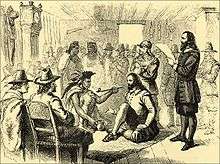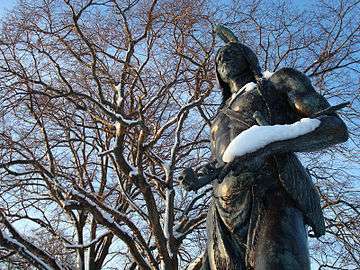Massasoit
.jpg)
Massasoit Sachem or Ousamequin (c. 1581 – 1661),[1] was the sachem, or leader, of the Wampanoag, and "Massasoit" of the Wampanoag Confederacy. The term Massasoit means Great Sachem.[2]
Background
Massasoit Ousamequin lived in Montaup, a Pokanoket village at the site of what is now the town of Warren, Rhode Island. He held the allegiance of a number of lesser Pokanoket sachems.

As outbreaks of smallpox had devastated the Pokanoket, Massasoit sought an alliance with the English against the neighboring Narragansett, who controlled an area the west of Narragansett Bay in present-day Rhode Island. Massasoit forged critical political and personal ties with the colonial leaders John Carver, Stephen Hopkins, Edward Winslow, William Bradford, and Miles Standish – ties which grew out of a negotiated peace treaty on March 22, 1621. Massasoit's alliance ensured that the Wampanoag remained neutral during the Pequot War in 1636.[3]
According to English sources, Massasoit prevented the failure of Plymouth Colony and the almost certain starvation that the Pilgrims faced during the earliest years of the colony's establishment.[3]
Uneasy alliance
There was some tension between Massasoit and the colonists when they refused to give up Squanto whom Massasoit believed to have betrayed him. This was not resolved until a visit by Edward Winslow to Massasoit in March 1623 when Massasoit was ill [4] and Winslow nursed him. After his recovery, Winslow reports that Massasoit said "the English are my friends and love me." Moreover, Winslow also noted that Massasoit felt duty-bound to observe that "whilst I live I will never forget this kindness they have showed me."[5]
Further pressure on the alliance came in later years as the colonists were insistent upon the acquisition of new lands to support their growing colony. In 1649, to alleviate tension and maintain the peace between his people and the colonists, Massasoit sold a tract of land fourteen miles square to Myles Standish and others of Duxbury. The sale took place atop Sachem Rock, a rock outcropping on the Sawtucket River in what is now East Bridgewater, Massachusetts. The site is listed on the National Register of Historic Places.
Children
Massasoit had six children: "Moanam", or Wamsutta, who was born sometime between 1621 and 1625; Pometecomet, Metacomet, or Metacom; a third son, Sonkanuchoo; and two daughters, one named Amie and one whose name is unrecorded. Soon after the death of Massasoit, Wamsutta and Pometecomet went to Plymouth and requested the Pilgrims to give them English names. The court named them Alexander and Philip. Wamsutta (Alexander), the eldest, became sachem of the Pokanoket on the death of his father.[6] Wamsutta died within a year, and his brother Metacom (Philip) succeeded him in 1662.[3]
Consequences
For nearly forty years, the Wampanoag and the English of Massachusetts Bay Colony maintained an increasingly uneasy peace until Massasoit's death. Throughout this time, and in order to maintain the peace, Massasoit sold lands which the English insisted on having. Roger Williams, when banished from the Massachusetts colony and on his way to Providence, was entertained by Massasoit for several weeks. Massasoit was humane and honest, never violated his word, and constantly endeavored to imbue his people with a love of peace. He kept the Pilgrims advised of any warlike designs toward them by other tribes.[6]
It is unclear when Massasoit died. Some accounts claim that Massasoit died as early as 1660; others contend that he died as late as 1662. Very likely, Massasoit was anywhere from eighty to ninety years old at the time. When Massasoit died, his son Wamsutta (Alexander) became his successor, but when Wamsutta also died in 1662, Metacom (Philip) succeeded him.[7] Of Massasoit's five children, the only child to survive King Philip's War in 1676 was his daughter, Amie, wife of Tispaquin.
Legacy

Perhaps unsurprisingly however, the half century of peace that Massasoit so assiduously negotiated collapsed soon after his death. Breaking with his father's diplomacy, and in response to increasing depredations into Wampanoag territory by his ally, Massachusetts Bay Colony, Wamsutta began to form an alliance with Connecticut Colony. Within a year of his succession, and almost immediately after appearing in front of the court in 1662, Wamsutta died suddenly. Metacom, Massasoit's second son, became sachem of the Pokanoket, and chief sachem of the Greater Wampanoag Confederacy. Metacom, also known as Philip, certainly believed that Wamsutta had been murdered at the hands of the English. Wamsutta's death was one of the leading factors that eventually led to King Philip's War, the bloodiest war in American history — indeed, more so than the American Civil War in terms of lives lost proportional to population.
When Roger Williams fled the Massachusetts Bay Colony to avoid arrest and deportation, he stayed the winter of 1635/36 with Massasoit, who later that spring gave Williams land along the Seekonk River. Governor Winslow of Plymouth Colony advised Williams to move his settlement to the other side of the river because his current location was within the bounds of Plymouth Colony. Williams did so and founded Providence Plantation which later became the state of Rhode Island.[8]
Statues of Massasoit by sculptor Cyrus E. Dallin stand near Plymouth Rock; outside the Utah State Capitol building; on the campus of Brigham Young University; at the Springville Museum of Art in Springville, Utah; and in Kansas City, Missouri (at the corner of Main Street and Emanuel Cleaver II Blvd). Massasoit Community College and Massasoit State Park, both located in Massachusetts, are named after him.
Fictional representation
The Pokanoket chief appeared in "The Mayflower Voyagers", a 1988 episode of the Peanuts television miniseries This is America, Charlie Brown.
At the beginning of the 1995 film adaptation of Nathaniel Hawthorne's Scarlet Letter, Massasoit dies and the tribe cremates his corpse. His son, Metacomet succeeds him as the tribe's new chief.
Massasoit was referred to as "Yellow Feather" in the 2013 novel Ghost Hawk by Susan Cooper.
See also
References
- ↑ "Native People" (page), "Massasoit (Ousamequin) Sachem" (section),MayflowerFamilies.com, web page:MFcom-Native Archived November 4, 2006, at the Wayback Machine.
- ↑ Bicknell, p. 12
- 1 2 3 "Pokanoket Wampanoag Leaders", Wampanoag Nation
- ↑ Alvin G. Weeks, Massasoit of the Wampanoags, 1919.
- ↑ Winslow, ch. 4
- 1 2
 Wilson, James Grant; Fiske, John, eds. (1900). "Massasoit". Appletons' Cyclopædia of American Biography. New York: D. Appleton.
Wilson, James Grant; Fiske, John, eds. (1900). "Massasoit". Appletons' Cyclopædia of American Biography. New York: D. Appleton. - ↑ Peirce, Ebenezer. Indian History", Zeviah Gould Mitchell, North Abington, Massachusetts, 1878
- ↑ "Roger Williams National Memorial", National Park Service
Sources
- "Native People" (page), "Massasoit (Ousamequin) Sachem" (section), MayflowerFamilies.com, webpage: MFcom-Native.
- Bicknell, Thomas Williams (1908). Sowams, with Ancient Records of Sowams and Parts Adjacent. New Haven: Associated Publishers of American Records.
- Winslow, Edward (1624). Good Newes from New England. London.
- Nathaniel Philbrick, Mayflower: A Story of Courage, Community, and War, New York 2006.
External links
 Media related to Massasoit at Wikimedia Commons
Media related to Massasoit at Wikimedia Commons "Massasoit". The New Student's Reference Work. 1914.
"Massasoit". The New Student's Reference Work. 1914. "Massasoit". The American Cyclopædia. 1879.
"Massasoit". The American Cyclopædia. 1879.
- Massasoit at Find a Grave